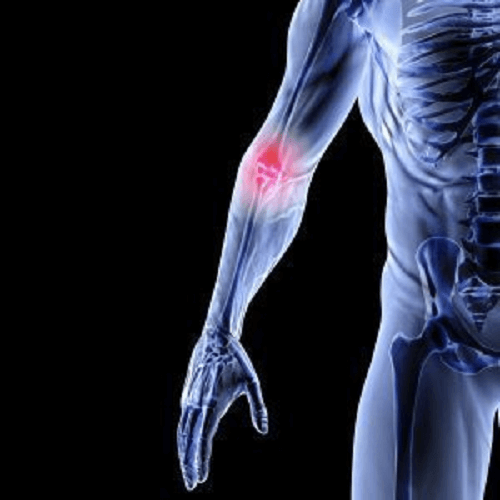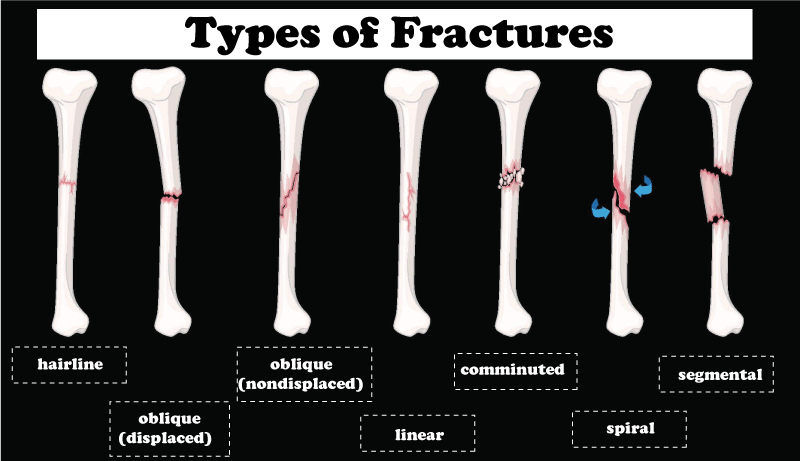Fracture DefinitionA fracture is a physical illness in which the continuation of any bones in the body is broken, either partially or completely. In more serious situations, the bone may shatter into several pieces, a condition referred to as "comminuted fracture." Any person of any age can suffer from a bone fracture, a highly frequent ailment. Bone fracture is a common type of injury. Every year, millions of individuals break a bone. Traumas such as falls, automobile accidents, or sports injuries are the most common causes of fractures. However, certain medical problems and repeated motions (like running) might increase your chance of having a certain kind of fracture. 
You might require surgery to fix a broken bone. Some people's bones can recover with just a splint, cast, brace, or sling. Depending on which bone is broken, where, and what caused it, it will take a different amount of time to recover fully. Bone Fracture VS BreakBroken bones and bone fractures both refer to the same injury. They can be used interchangeably. After they diagnose your broken bone, your healthcare practitioner might usually refer to it as a particular sort of fracture, as the medical name for a broken bone is "fracture." 
Kinds of Bone FracturesFractures come in a wide variety of forms. Your doctor will determine the sort of fracture you have based on a few factors, such as: Pattern: The word "fracture pattern" in medicine refers to the appearance or form of a break. Cause: Some fractures are described based on how they occur. Body part: The location of the bone fracture in your body. Fractures Identified by Pattern or StructureThe pattern of certain fractures is used to categorize them. This could be a break's orientation (if it runs in a straight line through your bone) or shape (if there are several line breaks). A single straight line breaks in the following fractures: Oblique Fractures-The pattern of this kind of fracture is angled. Transverse Fractures-The fracture line in this kind of fracture is horizontal. Longitudinal Fractures-Bone fractures that occur throughout the bone's length. Bones can fracture in a variety of ways other than in a single-straight line, including: Greenstick fractures, comminuted fractures, segmental fractures, spiral fractures. Fractures Identified by Their CausesA few fracture forms have names or classifications based on their etiology: Stress fractures- Sometimes known as hairline fractures. Buckle fractures- Sometimes known as impacted fractures. Location-Based Diagnosis of FracturesNumerous fractures are unique to the location in your body where they occur. Sometimes a location-based fracture might also be one of the other types of fractures mentioned above. For instance, a comminuted tibia, i.e., shin bone fracture, might occur after a hard fall. Open Fractures Vs Closed FracturesYour healthcare professional will categorize your fracture as open or closed. In an open fracture, the bone pokes through the skin. Compound fractures are another name for open fractures. Open fractures typically require more healing time and pose a higher risk of complications like infections. Although your bone doesn't protrude through your skin, closed fractures are nevertheless severe. Fractures with and Without DisplacementYour doctor may also refer to your fracture as displaced or non-displaced. This fracture occurs when the pieces of a bone shift so much after it is fractured that a space appears around the fracture. Non-displaced fractures still result in shattered bones. However, the pieces weren't dislodged far enough to cause alignment issues. The likelihood that a fracture will need surgery to be repaired is substantially higher. Who Gets a Bone Fracture?Anyone can experience a bone fracture. It's difficult to predict when someone may break a bone because traumas like falls, auto accidents, or sports injuries are frequently the reason. If osteoporosis has weakened your bones, you are more prone to shatter a bone. What Signs Indicate a Bone Fracture?Bone fracture signs and symptoms include- Pain, swelling, tenderness, inability to move a bodily part as easily as you normally can, discoloration, malformation, or bump that isn't normally found on your body. What Causes Fractures in Bones?Traumas are virtually always the root cause of bone fractures. Anything may shatter a bone in your body if it strikes it hard enough. Among the most frequent causes are: Accidents in automobiles, falls, and sports injuries. There are situations when a bone might fracture without any external impact. Stress fractures can be brought on by repetitive motions, such as jogging or engaging in sports. Like overuse syndrome, overusing your hands and arms over a long period can result in repetitive motion injuries. A stress fracture is more likely to cause if you play a musical instrument or use your hands, in the same manner every day at work. How can Bone Fractures be Identified?A physical examination and imaging studies will help your doctor determine whether you have a bone fracture. In some circumstances, if you are hospitalized following a trauma, this may be handled in the emergency room. If you are rushed to the ER, a group of medical professionals will stabilize you & treat your wounds according to their seriousness, especially if some of them are life-threatening. After you've been stabilized, you'll require imaging testing to confirm if there are any fractures. What Tests are Used to Detect Bone Fractures?At least one of the following imaging procedures will be required to capture images of your fracture: X-rays: An X-ray reveals the extent of your bones' damage and confirms any fractures. Magnetic Resonance Imaging: Your doctor can use an MRI to obtain a full view of the injury to your bones as well as the surrounding tissue. The ligaments and cartilage surrounding your bones will also be seen on an MRI. CT scan: An X-ray cannot offer your doctor or surgeon as comprehensive an image of your bones or surrounding tissue as a CT scan can. Bone scan: Healthcare practitioners use a bone scan to detect fractures that aren't visible on an X-ray. How are Fractures of the Bone Treated?Depending on the type of fracture, what caused it, and the degree of bone damage, a doctor will decide how to treat you. Immobilization You may only require a splint/cast if your bone fracture is minor and your bones have not moved much from their original positions (if it is non-displaced). Typically, splinting is used for 3 to 5 weeks. If you require a cast, the duration will probably be longer, usually 6 to 8 weeks. In both situations, you'll probably need further X-rays to ensure your bones are mended properly. Closed reduction A closed reduction is necessary to realign your bones for more serious breaks. Your healthcare professional will physically pull and push on the exterior of your body during this non-surgical technique to align the damaged bones inside of you. You will get one of the following to minimize your pain during the procedure:
Your healthcare practitioner will place you in a cast or splint after the closed reduction. Surgery for bone fractures Surgery is required for some bone fractures. There are a few methods your surgeon can use, depending on the sort of bone fracture you have and how severely your bones have been harmed. Internal fixation Your bones will be realigned (set) to their proper positions by your surgeon, who will then secure them so that they may grow back together and recover. Typically, they carry out a procedure known as internal fixation, in which your surgeon inserts metal into the bone to keep it in place while it recovers. To ensure that your bone can mend, you should limit how frequently you use that area of your body. Techniques for internal fixation include: Rods: A horizontal rod that is put through the middle of your bone. Plates and screw: To keep the parts together in place, metal plates are put into your bone. Pins and wires: Bone fragments that are too tiny for other fasteners are held in place by pins and wires. They are frequently utilized along with rods and plates. Some people have these insertions in place permanently. To get them out, you could require more procedures. External fixation Perhaps you require an external fixing. Your surgeon will insert screws into your bone on each side of a fracture inside your body, and they'll be connected to a bracket or brace that will go around the fractured bone outside your body. Before having an internal fixation, this is typically a quick method of stabilizing your fracture and giving it time to start healing. Bone grafting If the fracture is significantly dislocated or if the bone isn't reintegrating as it should, you may require bone grafting. To repair your broken bone, the surgeon will introduce more bone tissue. In order to keep the fragments together while the bone regenerates, physicians will often conduct an internal fixation after that. There are several sources for bone grafts:
Your bones will be stabilized after surgery. Before using it, as you did before the fracture, you'll need to wear a splint, cast, brace, or sling. Arthroplasty If you break a joint (such as your shoulder, elbow, or knee), you might require arthroplasty (joint replacement). Your surgeon will replace the injured joint with an artificial one after removing the damaged joint. Metal, ceramic, or robust plastic can be used to make the prosthetic joint (prosthesis). The replacement joint will move and appear like your normal joint. How can Bone Fracture Risk Be Reduced?Use these general safety recommendations to minimize your chance of injury:
The ConclusionAny bone can sustain a fracture, which can range in size from minor partial fractures to full breaks. The most frequent causes of fractures include physical trauma, excessive usage, and diseases like osteoporosis. In addition, as a person ages, their bones usually start to deteriorate. Their chance of breaking a bone rises as a result. The body may heal the majority of fractures; however, keeping shattered bones in place frequently requires medical assistance. These treatments might include everything from surgical screws and plates to external casts and splints.
Next TopicFriction Definition
|
 For Videos Join Our Youtube Channel: Join Now
For Videos Join Our Youtube Channel: Join Now
Feedback
- Send your Feedback to [email protected]
Help Others, Please Share










